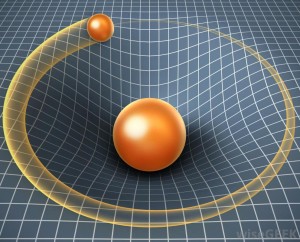Science Seen Physicist and Time One author Colin Gillespie helps you understand your world.
Fields of Dreams
Here is a mystery that needs help from armchair philosophers. Nowadays physics describes the world in terms of “fields”. What, then, is a field? It is weasel math that physicists invented to allow them to ignore the paradox of action at a distance.
In the annals of thought the concept of action at a distance has a long history. If I pull your arm you can see how the force acts on you. But how does the Earth pull on the Moon to make it swing around? In 1692, having based physics on action at a distance with his theory of gravity, Isaac Newton called it ‘so great an Absurdity that I believe no Man who has in philosophical Matters a competent Faculty of thinking can ever fall into it.’
Physics is a collection of belief systems. Like, say, the Abrahamic religions, these belief systems have much in common and they have their differences. This view of physics tends to be invisible. Many see it as an experimental science rooted in the nature of reality. In fact over the last hundred years physics has come to mostly mean theoretical physics. And few belief systems are more deep-rooted in mystery than those of mainstream theoretical physics. Central to them is the idea of fields. The field of gravity solves Newton’s problem, because the Earth’s field is over there; the Moon is swimming in it (and vice versa but the image doesn’t show that).
they have their differences. This view of physics tends to be invisible. Many see it as an experimental science rooted in the nature of reality. In fact over the last hundred years physics has come to mostly mean theoretical physics. And few belief systems are more deep-rooted in mystery than those of mainstream theoretical physics. Central to them is the idea of fields. The field of gravity solves Newton’s problem, because the Earth’s field is over there; the Moon is swimming in it (and vice versa but the image doesn’t show that).
A field is something one imagines as existing everywhere (if it does exist at all, that is). That is, it has a value at every point in infinite space and time. Almost anything can be a field. Anybody can invent a new one; physicists come up with fields every day. In other words, a field is a fancy way of saying we don’t know what’s really going on but we are not about to let that stop us doing physics.
Field theory facilitates a lot of physics calculations. A field is like a facile invitation to do math and this is where physics is building on insecure foundations. The math of fields assumes that the universe is infinite (a bad assumption) and that space is continuous (another bad assumption). The dominance of fields today is the result of a century of math-driven physics that has confronted physicists with a choice between despair and absurdity. Of course they could choose to see that, as a description of reality, fields are a bad idea. But that could send them back to school, a good idea that (we can sympathize) lacks sex appeal for physics PhD’s.
But fields obscure deep meaning and avoid key questions like: Do fields describe what’s really going on? Indeed, What is going on? is a question modern physics mostly chooses to avoid. So while in practice fields are useful, they’ve led physics far off track into an intellectual dead-end.
The lost-opportunity-cost to the economy, which depends on fundamental physics, is staggering. Maybe quadrillions of dollars. To whom should we look to solve this problem? Carlo Rovelli, an Italian physicist who wrestles with fundamental problems, suggested almost 20 years ago that others could help with the heavy lifting:
‘I think that it is fair to say that today we do not have a consistent picture of the physical world at all. … I think that the responsibility for the search for the new synthesis is not for physicists alone.’
It’s as true now as it was then. For example, in 1915 Albert Einstein’s theory of general relativity (a field theory) said that gravity is space. Then in a lecture on May 5th 1920 he acknowledged that this brings physics full circle back to the ether concept that his theory of special relativity is widely thought to have abolished. (Most physicists still fail to grasp this.) Bring on the philosophers.
The fundamental question, What is space? calls for a fundamental answer.
Sources:
Isaac Newton (1692), letter to Richard Bentley, Trinity College Library, Cambridge, UK, 189.R.4.47, ff. 7-8; http://www.newtonproject.sussex.ac.uk/view/texts/normalized/THEM00258
Carlo Rovelli (1997), “Halfway Through the Woods: Contemporary Research in Space and Time”, in John Earman & John Norton (eds.), The Cosmos of Science: Essays of Exploration, Pittsburgh: University of Pittsburgh Press, p. 180.
Image Credit: wiseGEEK, http://www.wisegeek.com/what-is-a-gravitational-field.htm

No comments yet.